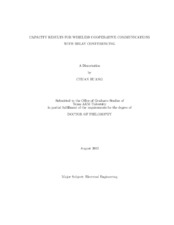| dc.description.abstract | In this dissertation we consider cooperative communication systems with relay conferencing, where the relays own the capabilities to talk to their counterparts via either wired or wireless out-of-band links. In particular, we focus on the design of conferencing protocols incorporating the half-duplex relaying operations, and study the corresponding capacity upper and lower bounds for some typical channels and networks models, including the diamond relay channels (one source-destination pairs and two relays), large relay networks (one source-destination pairs and N relays), and interference relay channels (two source-destination pairs and two relays).
First, for the diamond relay channels, we consider two different relaying schemes, i.e., simultaneous relaying (for which the two relays transmit and receive in the same time slot) and alternative relaying (for which the two relays exchange their transmit and receive modes alternatively over time), for which we obtain the respective achievable rates by using the decode-and-forward (DF), compress-and-forward (CF), and amplify-and-forward (AF) relaying schemes with DF and AF adopted the conferencing schemes. Moreover, we prove some capacity results under some special conditions.
Second, we consider the large relay networks, and propose a "p-portion" conferencing scheme, where each relay can talk to the other "p-portion" of the relays. We obtain the DF and AF achievable rates by using the AF conferencing scheme. It is proved that relay conferencing increases the throughput scaling order of the DF relaying scheme from O(log(log(N ))) for the case without conferencing to O(log(N )); for the AF relaying scheme, it achieves the capacity upper bound under some conditions.
Finally, we consider the two-hop interference relay channels, and obtain the AF achievable rates by adopting the AF conferencing scheme and two different decoding schemes at the destination, i.e., single-user decoding and joint decoding. For the derived joint source power allocation and relay combining problem, we develop some efficient iterative algorithms to compute the AF achievable rate regions. Moreover, we compare the achievable degree-of-freedom (DoF) performance of these two decoding schemes, and show that single-user decoding with interference cancellation at the relays is optimal. | en |


